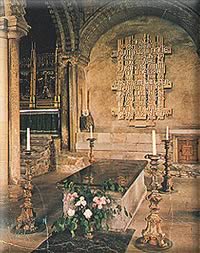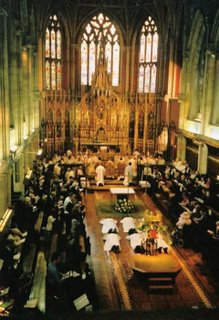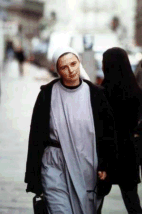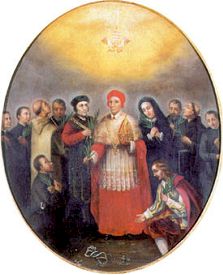Buona festa!
Today we honour St Philip Neri, one of the most attractive saints in the Calendar and one who is very close to my heart. I was an altar-boy at the London Oratory (and later a Brother of the Little Oratory); at University I got to know the Oxford Oratory and, while a seminarian in Rome, made frequent trips to the Roman Oratory. St Philip used to greet the English seminarians with the words
Salvete Flores Martyrum (Hail! Flowers of the Martyrs) - this was, after all, the age of the English martyrs - and the English College (in my time, at least) provided the music at the
Chiesa Nuova for his feast. I remember I was choir-master at the Roman Oratory this time five years ago!
Last year I was invited to preach at the London Oratory on this great feast, followed by a wonderful festal lunch. As a tribute to this great priestly saint, I take the liberty of posting my words:
Sermon for St Philip's DayTen years ago an exhibition was held in Rome to celebrate the 400th Anniversary of St Philip’s death. A large collection of pictures was gathered relating to the life and cult of the ‘Apostle of Rome.’ Some were familiar, others more obscure: there was Guido Reni’s famous painting of St Philip with the Madonna and child; ‘St Philip celebrating Mass,’ ‘St Philip interceding for the city of Turin,’ ‘St Philip in glory,’ even the miracle of St Philip in which Cardinal Orsini (the future Pope Benedict XIII) was saved from an earthquake in 1688.
St Philip was shown in many different guises, yet it is intriguing to note that in the vast majority of them, he wears a chasuble. This might not at first seem worthy of comment. Of course, many of the saints were priests, but St Philip is unusual in having actually appropriated the priestly vestments as one of his iconographic symbols. Not even the great Cure d’Ars, the patron of priests, can claim this as his motif.
This tells us something very important about the spirit of St Philip and about the centrality of the Priesthood in his life. He lived at a time of great reforming saints, and though, in so many ways, he is one of them, he also stands apart. In founding the Congregation of the Oratory, St Philip was not chiefly concerned with any ‘specialised’ work or grand strategy, but rather focussed on the priestly apostolate per se, based around administering the sacraments and preaching the Gospel.
He was not primarily concerned with education or missionary evangelisation, as his friend St Ignatius was. He produced no learned tomes, like St Robert Bellarmine. He followed no system of Church reform, like St Charles Borromeo. He did not devote himself to the sick in the same way as St Camillus. He did not immure himself within a cloister, like his fellow Florentine, St Catherine dei Ricci. No, St Philip taught his followers through the school of his example, his words were inscribed not in books but on the hearts of his penitents, he reformed Church and society through his ministry in the confessional, he brought the medicine of the sacraments to sick souls, and though he lived a life of deep contemplation, his was not an enclosed life and Rome was his cloister. St Philip’s life was a priestly life of charity and, of course, at the heart of that was the Holy Sacrifice of the Mass. That’s why the priestly chasuble is a fitting symbol of this great saint of the Eucharist. It was, indeed, no coincidence that our saint died on 26th May 1595, which (like this year) happened to be the Solemnity of Corpus Christi.
It is well known that this ‘choicest of priests’ had a great devotion to the Blessed Sacrament, and this was most visible when he celebrated Mass. His disciple and biographer, Antonio Gallonio, tells us that during Mass ‘he would suddenly be so filled with the Holy Spirit that he could hardly pour the wine and water into the chalice in the usual way; his hands would be raised up so that he looked as if he were dancing or jumping up.’ Throughout his life, we are told, St Philip continued ‘to receive those assaults of divine love, pierced by those darts of grace, so that his whole body burned with the divine flame, the fire of heavenly love.’ He elevated the Host and Chalice quickly for fear that he might never be able to lower his arms. Such were these ‘assaults of divine love’ that to distract himself he would sometimes walk the length of the altar, talk to people around him, and make comments to the server about the quality of the light. As he vested in the sacristy, he would listen to humorous poems or play with little dogs. If it had been any other priest, these actions would have seemed irreverent; but they were the fruit of a deep union with God - manifestations of his sanctity that are uniquely his own and can never be imitated.
The Oratory has never been inward-looking – it originated for the sanctification of souls living in the world. Cardinal Newman said that ‘it was his mission to save men, not from, but in, the world. To break the haughtiness of rank, and the fastidiousness of fashion, he gave his penitents public mortifications; to draw the young from the theatres, he opened his Oratory of Sacred Music; to rescue the careless from the Carnival and its excesses, he set out in pilgrimage to the Seven Basilicas.’
Many of the most celebrated aspects of St Philip’s ministry flowed from and were directed towards the Eucharist. He promoted the Forty Hours devotion, as a means of reparation for the sins of the Carnival. His concern with Sacred Music and his friendship with Palestrina, Victoria and Anerio resulted from the appreciation that music lifted up the mind and heart to God and provided a sense of the gloria Dei. Fine music and liturgical excellence became (and remain) hallmarks of the Oratory of St Philip.
St Philip also re-built the church of Santa Maria in Vallicella – the resulting edifice is still called the Chiesa Nuova, the ‘New Church.’ Fr Faber called Rome the ‘city of the Blessed Sacrament’ – and this is true if only on account of the great number of churches and chapels, each of them a shrine to the Holy Eucharist. The Rome of St Philip was a city of scaffolding, as many churches (often with ancient pedigrees) were rebuilt and renovated. It was an age when faith in the Blessed Sacrament was expressed so vividly in stone and fresco, in the swirling cherubs and flamboyant side altars. In rebuilding the church of Santa Maria in Vallicella, the Oratorians had to face the opposition of the local inhabitants – poor Fr Lucci, who superintended the work, was even attacked by arrows fired from crossbows, though he was never hit – but the new church was a veritable sermon in stone, in praise of the Blessed Sacrament and of the Blessed Virgin.
Just as he insisted on the daily celebration of Mass – which was not the common priestly practice of his times – so St Philip preached the necessity of frequent Communion. And here he gives his children living in the twenty-first century a timely reminder. St Philip encouraged the frequent use of the sacraments, but he warned his disciples against becoming communicants of routine and habit. The Bread of Angels must never be received unthinkingly or just to save face. Our saint once said, ‘let us all go to the Eucharistic table with a great desire for that Sacred Food: Sitientes! Sitientes!’ - thirsting, thirsting. He thought it best to acquire a true thirst, gained through prayer, before approaching the Fountain of Eternal Life.
St Philip’s favoured means of preparing for frequent Communion was frequent Confession. Like the Cure d’Ars and Padre Pio, St Philip became a ‘prisoner of the confessional.’ At San Girolamo, he would spend the morning hearing confessions before celebrating the last Mass of the day. Another early biographer, Fr Bacci, wrote: ‘while he was hearing confessions, the fire which burned within his breast was so ardent, that many of his penitents felt their hearts inflamed with the love of God during confession, and especially when he gave them absolution.’
The Church has long held to the maxim: Sanctum sanctis, holy things are for those who are holy. Of course, we are all sinners trying to become saints, and the Eucharist is the supernatural food that strengthens our will and helps us resist temptation. But frequent Holy Communion only bears fruit if we prepare for it properly. In order to receive Communion, we need to, firstly, have a ‘right intention.’ This is what St Philip meant when he repeated the words: Sitientes! Sitientes! thirsting, thirsting. We should approach the Holy Sacrament not out of meaningless habit but as a result of true devotion. Secondly, we need to be in a state of sanctifying grace, free from mortal sin. St Philip knew both the potential and the dangers facing human nature – as a remedy to sin he proposed frequent Confession, so that his penitents could be duly prepared to frequently receive the Bread of Life.
Fr Faber used to say that ‘Jesus lives many lives in the Blessed Sacrament…For in each tabernacle where He is reserved, He meets with different treatment, performs different miracles of grace, receives different petitions of want and sorrow, abides a different length of time, and is the object of different degrees of love. There is in a sense what may be called an outward biography to every consecrated Host.’ Through Holy Communion, the Lord gives Himself to us and takes possession of our souls – in that sense, there is an ‘outward biography,’ an adventure of grace behind every Communion that we worthily receive.
What better method is there of truly participating in the Eucharistic mystery than through the practice of frequent communion, as taught us by St Philip? The present Holy Father, Benedict XVI, is quite clear about what true participation in the Mass means. ‘If the liturgy degenerates into general activity,’ he writes, ‘then we have radically misunderstood the “theo-drama” of the liturgy and lapsed almost into parody…Instead one must be led toward the essential actio that makes the liturgy what it is, toward the transforming power of God, who wants, through what happens in the liturgy, to transform us and the world.’ Indeed, ‘anyone who grasps this will easily see that it is not now a matter of looking at or toward the priest, but of looking together toward the Lord and going out to meet him.’
As we keep the ‘Year of the Eucharist’ and celebrate today’s Feast during the Octave of Corpus Christi, let us look toward the Lord and go out to meet him, together with Our Holy Father St Philip! Let us adore the Eucharistic Lord more fervently and let our minds and hearts rise up to the Lord through the beauty of the Sacred Liturgy. Let us approach the altar with true devotion – Sitientes! Sitientes! (thirsting, thirsting) –and worthily prepare ourselves through the frequent use of the confessional. Let us make the Eucharist the source and summit of our lives.
Allow me to close with the words used by Mgr Ronald Knox in this very pulpit exactly 54 years ago: ‘Reverend Fathers, you do not keep St Philip to yourselves; you share him with the world. Pray for us others, that we too may learn something of his spirit.’
St Philip Neri, ‘choicest of priests’ – pray for us who have recourse to thee.
Labels: Saints









 Outside the Conference Centre at Ushaw College (near Durham) is a strange wall with arches, as seen in the picture above. At first glance it might appear to be an extension of Hadrian's Wall or some medieval ruin, but it was actually built for the Ushaw version of handball. This is thought to have been brought to Ushaw from its mother foundation, the English College, Douai. Similar games were played at Downside, Ampleforth and elsewhere - an unexpected survival from recusant times. I wonder if some of the English martyrs, many of whom trained at Douai, happily spent their leisure time playing this fast-moving game?
Outside the Conference Centre at Ushaw College (near Durham) is a strange wall with arches, as seen in the picture above. At first glance it might appear to be an extension of Hadrian's Wall or some medieval ruin, but it was actually built for the Ushaw version of handball. This is thought to have been brought to Ushaw from its mother foundation, the English College, Douai. Similar games were played at Downside, Ampleforth and elsewhere - an unexpected survival from recusant times. I wonder if some of the English martyrs, many of whom trained at Douai, happily spent their leisure time playing this fast-moving game? His Feast, of course, is on 25 May and, since this was the day after my Ordination, I chose him as my priestly patron. This, incidentally, is a good thing to do when one approaches Ordination. Ronald Knox, for example, chose St Hilary of Poitiers and took the name in much the same way as taking a name at Confirmation.
His Feast, of course, is on 25 May and, since this was the day after my Ordination, I chose him as my priestly patron. This, incidentally, is a good thing to do when one approaches Ordination. Ronald Knox, for example, chose St Hilary of Poitiers and took the name in much the same way as taking a name at Confirmation.
















